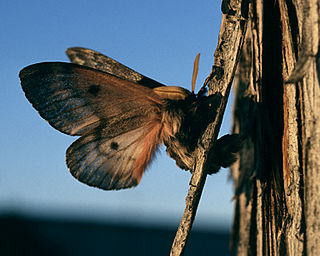
Coloradia is a genus of moths of the family Saturniidae. There are nine described species found in Mexico and eastern North America. The genus was first described by C. A. Blake in 1863.

The dryandra moth is a species of moth that is considered to be the sole member of the family Carthaeidae. Its closest relatives are the Saturniidae and it bears a resemblance to many species of that family, bearing prominent eyespots on all wings. The common name is derived from the Dryandra shrubs of the genus Banksia, on which the larva of this species feed, and is hence restricted to the south-west of Western Australia where these shrubs grow. Other Grevillea shrubs may also be used as host plants.

Actias sinensis, the Chinese moon moth, is a moth of the Family Saturniidae. It is found in China, Taiwan, Vietnam, Myanmar, India and Thailand. The species was first described by Francis Walker in 1855.

Caligula is a genus of moths of the family Saturniidae. It is primarily an Oriental genus, found in India, China and Southeast Asia. The genus is often treated as a synonym of Rinaca. It is named after Roman emperor Caligula.
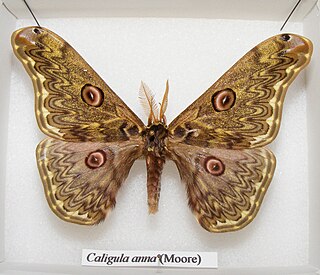
Caligula anna is a moth of the family Saturniidae. It is found in south-eastern and southern Asia, including China.

Saturnia spini, the sloe emperor moth, is a moth of the family Saturniidae. The species was first described by Michael Denis and Ignaz Schiffermüller in 1775. It is found from eastern Austria and Poland across eastern and south-eastern Europe to Greece, Turkey, Armenia, Ukraine, Crimea and Kazakhstan.

Antherina is a monotypic moth genus in the family Saturniidae erected by William Elford Leach in 1815. Its only species, Antherina suraka, the Suraka silk moth, was first described by Jean Baptiste Boisduval in 1883. It is found on Madagascar and Mayotte.

Automeris zozine is a moth of the family Saturniidae. It is found in Mexico, south to Guatemala and Colombia.

Perisomena caecigena, the autumn emperor moth, is a moth of the family Saturniidae. The species was first described by Franz Josef Kupido in 1825. It is found in Italy and then from south-eastern Austria through Hungary, Slovenia, Croatia, Serbia, Albania, the western Ukraine, Romania, Bulgaria and Greece to most of Turkey and the Caucasus Mountains of the Republic of Georgia, Armenia and Azerbaijan. There is also an isolated population in the mountains of Lebanon and Israel. Subspecies stroehlei is endemic to the Troodos Mountains of Cyprus.

Anisota virginiensis, the pink-striped oakworm moth, is a species of silk moth of the family Saturniidae.
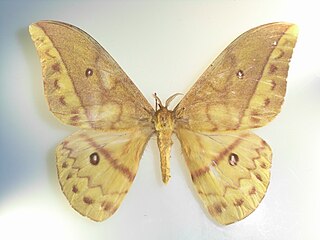
Pseudantheraea discrepans is a species of moth of the family Saturniidae first described by Arthur Gardiner Butler in 1878. It is found in Africa, from Ivory Coast to Uganda in the north and from Angola to the Democratic Republic of the Congo in the south.
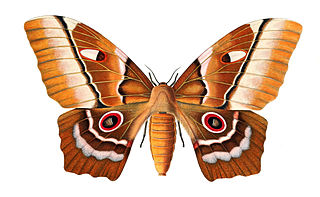
Pseudimbrasia is a monotypic moth genus in the family Saturniidae described by Pierre Claude Rougeot in 1962. Its only species, Pseudimbrasia deyrollei, described by James Thomson in 1858, is found in the mid-latitudes of Africa.

Automeris is a genus of moths in the family Saturniidae and the subfamily Hemileucinae. As of 1996 there were 124 species, and more have since been described. These moths are generally characterized by the eyelike patches on the hindwings and the leaflike pattern on the forewings, an example of crypsis. The genus was first described by Jacob Hübner in 1819 and it is distributed in the Neotropic ecozone.

Microdulia is a genus of moths in the family Saturniidae first described by Jordan in 1924. It contains only one species, Microdulia mirabilis, described by Rothschild in 1895, which is found between 35° and 47°S in Chile and Neuquén in Argentina.
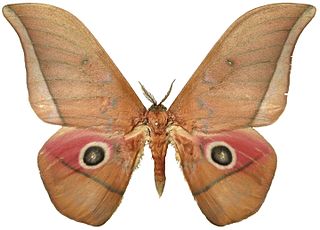
Lobobunaea acetes is a species of moth in the family Saturniidae first described by John O. Westwood in 1849. It is found in Angola, Cameroon, the Democratic Republic of the Congo, Guinea, Kenya, Nigeria, Rwanda, Sierra Leone, Tanzania and Uganda.

Copaxa curvilinea is a species of moth in the family Saturniidae first described by William Schaus in 1912. It is found in Central America, including Nicaragua and Costa Rica.

Rhescyntis hippodamia is a species of moth in the family Saturniidae first described by Pieter Cramer in 1777. It is found from Mexico to Brazil.
Actias callandra, the Andaman moon moth, is a moth in the family Saturniidae. It is found in India.





















